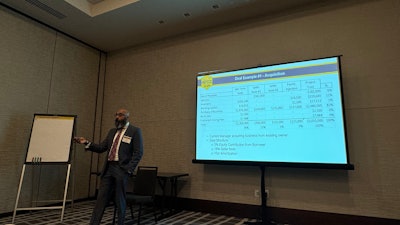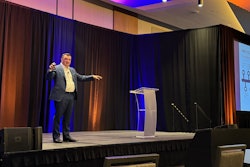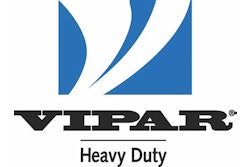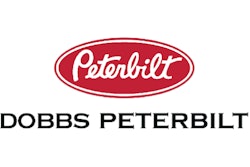
HD Repair Forum attracted heavy-duty repair shop owners, managers and others to Frisco, Texas, for two days of talking shop. Sessions included a look at industry statistics through PPG's AdjustRite software, exploring franchising opportunities, looking at new technologies and more.
On Wednesday afternoon, attendees broke out into individual sessions that focused on, among other things, growing profits and growing the business.
Working with Adjusters and Managing Costs
John Ascheman, senior application engineer with 3M's automotive aftermarket division, took aim at shop supplies. Ascheman has a background in both collision and claims adjustment, giving him perspective from both sides of the process.
By tracking the shop supplies used on each repair, Ascheman says shops can not only deliver better files and recoup more costs, they can better manage their inventory, controlling expenditures and, ultimately, repair times.
"The goal for inventory management is to reduce the workload of inventory management," he says. "You can use the information from those systems to forecast what you're going to need for the future. You can't measure what you don't track and you can't track what you don't measure."
Ascheman says effective inventory management creates more control. With the right system in place, shop owners and managers can see what was removed, when it was removed, who removed it, where it was removed from and why it was removed.
"Just having an eye on it can increase those profits as well and reduce those costs," Ascheman says. "You have less product on hand that you don't need. You can start having more money on hand."
He also offered advice on navigating conversations with insurance adjusters, many of whom are virtual since the pandemic. Adjusters also bear a burden of proof, he says, and they never want to overpay a claim. They need to support their file with documentation, including photos, invoices and other paperwork.
"Everything has to be tracked. If you can't see it, don't write it," Ascheman says. "If you can't see it, we can't document it. If you can't document it, you don't get paid for it."
Ask the adjuster up front how the repair shop can help them support their file, Ascheman advises.
"It's an uncomfortable job for adjusters. They only give bad news and no one likes them," he says. But by educating adjusters on the requirements for a complete, safe heavy-duty repair, shops can slowly make changes in the industry.
"We can all make more money for doing more work," Ascheman says. "But that's hard. We can make more money and do the same amount of work."
Keeping Track of Profits and Losses
Ron Kuehn from Collision Business Solutions talked to attendees about ways to strategically maximize profits in their shop.
"The fastest way to fix this is not by trying to figure out little things in the shop," he says. "It all starts with gross profit. Let's not get into a long country song about labor rates or add the extra verse about hard-to-find technicians."
Instead, look at what the business does that it's not getting paid for.
Kuehn spoke of a business that cleaned the cars for free at the end of the repair. Instead of performing the task for free, he added a line item for a cleaning fee. About 60% of the customers accepted it. The others, he did it anyway and then wrote it off as a marketing expense.
The most profitable businesses are constantly looking for opportunities like that, he says.
Kuehn also recommended analyzing what parts of your business make the most profit. Paint should make more profit than body work because the business covers the expense for more of the paint tools. Technicians in the body shop provide their own tools, and should therefore make more money.
He pointed out that more ADAS-related work, such as calibration, is coming along with more technically advanced vehicles.
"You have to make more gross profit in those areas to cover those expenditures and the ones coming down the road," Kuehn says, plus the liability for setting up safety systems such as ADAS on a large, heavy truck.
There are also ways to configure the shop so that it makes more money. Kuehn says many shops aren't allowed to mark up sublet, so instead of sending that money out of the company, they open up a sublet business, like ADAS calibration.
In the end, however, collision repair businesses must find ways to increase labor hours.
"The collision repair business does one thing. The whole model is designed because you can convert labor hours to dollars," Kuehn says. "You don't sell parts. You sell parts because your business converts labor hours to dollars."
Financing Options
John Walcher from Veritas Advisors, and Tipu Chauhdary, senior vice president of Byline Bank, say that if you're not at the table, you're probably on the menu.
"If you're not growing, you're not going to be able to afford to keep your book of business," Walcher says. "We're going to see an evolving industry, not just technology. We're seeing institutional money now, looking at the industry."
That includes private equity groups, Walcher says, who have to find new ways to deploy their money.
"This industry is ripe for some consolidation. If nothing else, you've got to be aware of it. You've got to know who you're competing with," he says.
Walcher discussed expansion solutions such as using brownfields or greenfields to expand the business, adding capacity by investing in your staff, and navigating mergers and acquisitions that strengthen the brand.
Chauhdary's part of the session focused on paying for those expansions. His bank, Byline Bank in Chicago, is a top five Small Business Association lender with $10 billion in total assets.
"Any time we finance a project, there's a guarantee from the government," he says about the SBA program. "God forbid, something goes wrong, we can recover our money."
SBA loans have benefits for the business owner, too. These include a longer amortization time, lower down payments and no borrower covenants.
"There are a multitude of uses for the program," Chauhdary says, including buying real estate, equipment, marketing, working capital and more. He showed examples of borrowers wanting to buy a business, buy out a partner, buy real estate and more.
Chauhdary also discussed other forms of financing, such as owner financing and vendor financing, that can work with an SBA loan to get a deal done, even ways to get borrowers to a zero down payment, provided they meet other requirements.










